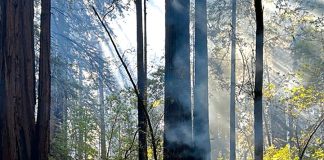Thomas Hogye, an avid fly fisherman, won a hat for knowing the San Lorenzo River is 29.4 miles long. This was the first of many interesting facts shared at the State of the San Lorenzo River Symposium held at the Zayante Fire House last weekend.
Fish, fire, floods and cannabis were topics included in the presentations about the San Lorenzo watershed from local, state and federal environmental agencies. Greg Pepping, executive director of the Coastal Watershed Council, introduced the symposium as a way, he said, to “increase the scientific awareness of our community.”
Assemblyman Mark Stone, the first speaker, and an avid open ocean swimmer, waded into issues of climate change and water. Stone reported California “leads the world in green house gas reduction” and is sponsoring an upcoming symposium on ocean acidification for 10-12 countries. Ocean acidification includes “treatments used on Carmel golf courses that wash out to the ocean and become toxic to algae.”
Stone said, “keeping water in the ground,” manages water in the face of shrinking snowpack. Both slowing down water from storms, and using septic systems, supports ground water recharge. San Lorenzo Valley has the highest concentration of septic in the country, reported Stone.
Large purple pipes out by Castroville recycle reclaimed water, a best practice used to reduce the 80 percent of the state’s water that goes to agriculture, reported Stone. Funds from a recent water bond will be spent on removing sediment in waterways and could increase groundwater storage by 25-30 percent in the Central and Sacramento Valleys.
Sustainable fish populations indicate the sustainability of the water system as a whole. “If we can manage fish, we are doing the right thing,” said Stone. Water conservation is a key component of sustainability. Monterey Bay residents conserve better than most: an average person in Los Angeles uses 100 gallons of water a day, while Monterey Bay residents use about half that amount.
During the drizzly morning, attendees enjoyed tea and snacks donated by Trader Joes. And just behind the Trader Joes is where research geologist Amy East, from the U.S. Geological Survey Pacific Coast and Marine Sciences Center, gathered the 112 water samples she used to show 2017 brought a 165 percent higher than average increase in rainfall, including nine flood events and “one 10-year flood.” Landslides also caused a 10-fold increase in the sediment in water. Sediment impacts fish and may warrant coastal dredging in the future. East shared that San Lorenzo Valley is part of a “small, steep habitat,” and that we are going to “swing from very dry to very wet,” in upcoming years.
Scott Creek, Waddell Creek and the San Lorenzo River are a few of the 30 waterways per year where Maryna Sedoryk, a UC Santa Cruz graduate and fisheries biologist from the Department of Fish & Wildlife, goes to count the actual numbers that add up to “endangered” and “threatened.” Endangered Coho salmon in Scott Creek dropped from a count of 325 in 2005, to less than five in 2012; a similar count of the Steelhead population showed a decline from 440 in 2004 to 140 in 2012.
Residents can help fish populations by steering clear of pebble piles in streams and the near-by dug-up areas: fish make these when laying eggs. Another way to help is to open mail from Fish & Wildlife and respond. In order to do her work, Sedoryk must write to homeowners and get permission to walk through the streambeds behind their homes. If too many folks don’t answer her letters, she can’t navigate the whole stream. And if you see streambed destruction you can report it to Fish & Game ‘s anonymous CalTIP hotline: 1 888 334 – 2258.
Protected riparian habitat includes the 50 feet on either side of a stream or waterway, reported Kristen Kittleson, a Santa Cruz County fishery resource planner. This special riparian zone improves water quality; provides insect habitat which in turn benefits fish; protects the trees that shade fish and stabilize stream banks; and provides migration corridors for mountain lions. Building, clearing, grading, and dumping of debris are all prohibited in this areas.
Removal of the large woody debris in streambeds is also a no-no; fallen wood increases fish habitat and reduces flooding.
The upcoming new Felton Library will have a riparian demonstration garden, where visitors will learn about riparian restoration. Native riparian plants include flowers and drought tolerant plants that attract butterflies and hummingbirds.
Afternoon presentations heated up with talk of cannabis, fire, and guns. CalFire Division Chief Rich Sampson reported, 50 percent of current timber harvest is now illegal operations of timber converted to cannabis. Environmental damage from illegal cannabis cultivation includes soil erosion, inappropriate grading, landslides and damage to creeks. Sampson shared slides of illegal grows and the fiery remains of blackened, charred cars from an illegal mountain “chop shop” of hoarded cars and hazardous materials.
Fires start at illegal campsites but are difficult to access, “We don’t even know half this stuff is out there, if we can even get there,” said Sampson. And, while showing slides of another illegal grow site, he said, “We might get an engine up here, might not be able to turn around and get out.”
While “redwood forests always have fire,” the increased population in the mountains diverts fire suppression resources from saving forests to protecting people and structures, leaving “no time to put the fire out.”
Residents can help by assuring fire access to their homes. “Imagine everything green around your house on fire” suggested Sampson, and evaluate whether a fire truck would have room to get through.
Michelle Leicester, a scientist from the Department of Fish & Wildlife, gave a slideshow presentation including pictures of an automatic rifle found at an illegal grow site. Cartel-controlled cannabis growing poses the most risk for law enforcement.
According to Leicester, illegal cannabis cultivation does even more damage than clear cutting, erosion, slope degradation, and stream damage from fallen slag. She says, “someone with a generator who wants 24 hour grow” can light up the entire sub-basin of a watershed, interrupting circadian rhythms.
Sea otters in Monterey Bay are also testing positive for micro-system toxin poisoning, due to the high amounts of nutrients and fertilizers used in illegal cannabis cultivation. Fish & Wildlife has found “carbofuran, a pesticide used to kill lions,” at grow sites, and open, 50 lb. bags of fertilizers. “A million little grows add up to a big impact,” Leicester reported. Creek water is also diverted and pits are filled with chemicals.
The Department of Fish & Game Marijuana Enforcement Team and Watershed Enforcement Team (WET) can issue citations for illegal culverts, water diversion, littering, and poaching birds, mammals and fish. “Each day is a new offense” so fines can add up quickly, but “How much can our water resources take before we reach a tipping point?”
Cisco Lopez, a second-generation farmer, rounded out the presentation by putting in a good word for local, organic, legal cannabis cultivation. Organic cannabis is outdoor cannabis because “bugs love living indoors.” Outdoor growing also saves electricity. He uses natural fertilizers including horse and chicken manure, fireplace ash and bone meal, and two cats, a dog, and gopher wire to control the rodent population. Using a milk and water solution in the soil also encourages the growth of beneficial bacteria and discourages powdery mildew. Recycling the soil used for cultivation also reduces the impact on the environment. “The more we can enforce on the bad actors,” reported Lopez, “the better everyone will be.” The biggest threat, he said, “is those who cut corners.”
About 100 people enjoyed the presentation sponsored by the Resource Conservation District, Coastal Watershed Council, the City of Santa Cruz Water Department, the San Lorenzo Water Department, and the County of Santa Cruz. The Natural History Museum sponsored a guided walk after the presentation, and the Zayante Fire House supported the event by providing the facilities. The Valley Women’s Club and the local subunit of the American Fisheries Society presented information tables on environmental issues and local fish.
One attendee reported that he lived on the river in Brookdale. He used to see the salmon spawn in the river, but “it’s been a couple of years since I’ve seen one.” Gary Lindstrom came from Aptos to learn, because, “ I fight for the things most people want to do but don’t have time to.” A valley resident, Jim Fitzgerald, summed it up as follows, “I’m really interested. I have a deep love and appreciation for nature which drives everything else.”













